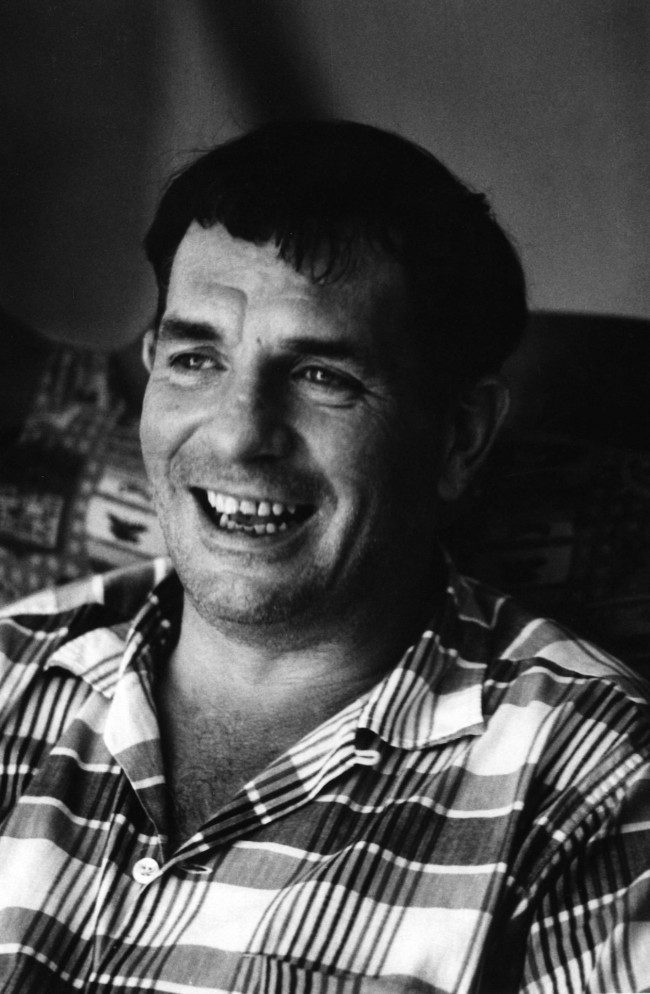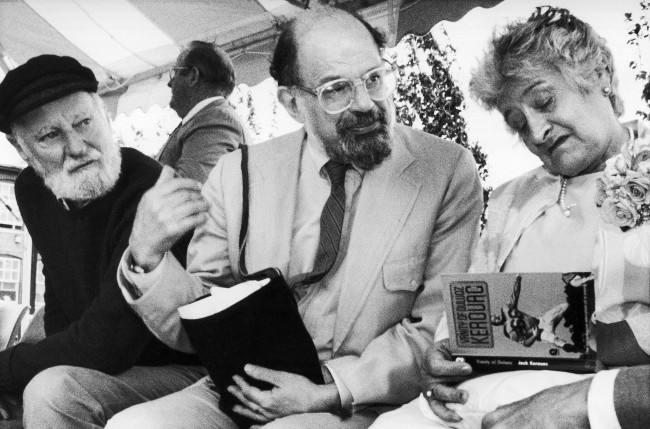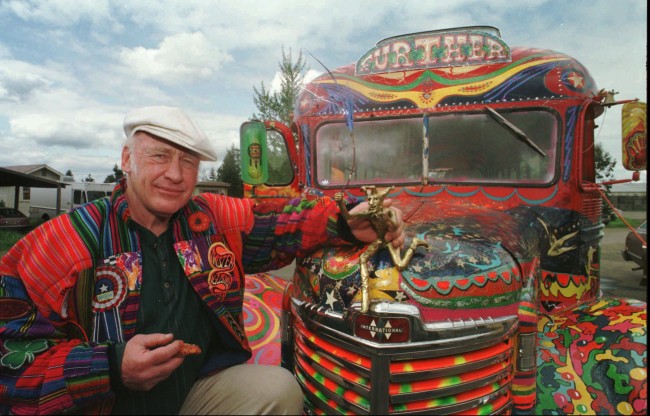Neal Cassady Shall Be Justified: Read The Joan Anderson Letter That Inspired Jack Kerouac’s On The Road

In 1950 Neal Cassady chocked down mouthfuls of speed and wrote a 16,000 words, 18-page letter to hgis friend Jack Kerouac. In it he recalled a trip to Denver and a dalliance with a Joan Anderson. Kerouac was writing On The Road. After reading Cassady’s letter he began it anew.
Kerouac was inspired. Others could be too, now that Neal Cassady’s letter has been found. And it’s for sale. It was thought lost. In 1968, Kerouac told The Paris Review in 1968 that Allen Ginsberg had lent the letter to a friend who had dropped it into the water:
I got the idea for the spontaneous style of On The Road from seeing how good old Neal Cassady wrote his letters to me, all first person, fast, mad, confessional, completely serious, all detailed, with real names in his case, however (being letters). I remembered also Goethe’s admonition, well Goethe’s prophecy that the future literature of the West would be confessional in nature; also Dostoyevsky prophesied as much and might have started in on that if he’d lived long enough to do his projected masterwork, The Life of a Great Sinner. Cassady also began his early youthful writing with attempts at slow, painstaking, and all—that—crap craft business, but got sick of it like I did, seeing it wasn’t getting out his guts and heart the way it felt coming out. But I got the flash from his style. It’s a cruel lie for those West Coast punks to say that I got the idea of On The Road from him.
All his letters to me were about his younger days before I met him, a child with his father, et cetera, and about his later teenage experiences. The letter he sent me is erroneously reported to be a thirteen—thousand—word letter…no, the thirteen—thousand—word piece was his novel The First Third, which he kept in his possession. The letter, the main letter I mean, was forty thousand words long, mind you, a whole short novel. It was the greatest piece of writing I ever saw, better’n anybody in America, or at least enough to make Melville, Twain, Dreiser, Wolfe, I dunno who, spin in their graves. Allen Ginsberg asked me to lend him this vast letter so he could read it. He read it, then loaned it to a guy called Gerd Stern who lived on a houseboat in Sausalito, California, in 1955, and this fellow lost the letter: overboard I presume. Neal and I called it, for convenience, the Joan Anderson letter…all about a Christmas weekend in the pool halls, hotel rooms and jails of Denver, with hilarious events throughout and tragic too, even a drawing of a window, with measurements to make the reader understand, all that.
Now listen: this letter would have been printed under Neal’s copyright, if we could find it, but as you know, it was my property as a letter to me, so Allen shouldn’t have been so careless with it, nor the guy on the houseboat. If we can unearth this entire forty—thousand—word letter Neal shall be justified.

Poets Lawrence Ferlinghetti, left, and Allen Ginsberg look on as Stella Kerouac, right, autographs one of her late husbandÂs books, during the dedication of the Jack Kerouac Commerative, a work of public art in Lowell, Massachusetts historic district Saturday, June 25, 1988.
The letter had not been lost. But Ginsberg had been remiss. He’d posted Cassady’s he letter to Golden Goose Press in San Francisco. It arrived. But no-one opened it. And when the company folded, a firm in the same office block took possession of the notes and letters. Los Angeles performance artist Jean Spinosa’s father took it home. She says:
“My father didn’t know who Allen Ginsberg was, he didn’t know Cassady, he wasn’t part of the Beat scene, but he loved poetry. He didn’t understand how anyone would want to throw someone’s words out.”

Author Ken Kesey poses with the magic bus Further, a descendant of the vehicle that carried him and the Merry Pranksters on the 1964 trip immortalized in the Tom Wolfe book, “The Electric Kool-Aid Acid Test.” Kesey is taking the bus to the Rock and Roll Hall of Fame and Museum for an exhibit on the psychedelic 1960s.
Cassady would join Ken Kesey’s Merry Pranksters, a band immoralied in Tom Wolfe’s The Electric Kool-Aid Acid Test.
This short clip features Neal Cassady and Ginsberg in conversation:
Even though Jack Kerouac coined the phrase and Allan Ginsberg and William S. Burroughs are familiar names associated with the movement, it was really propelled into existence by an infamous figure, Neal Cassady. A myth and a legend in his own right, Cassady really manipulated the marionette strings to which Ginsberg and Kerouac were attached. He became Kerouac’s muse for which he was able to finally complete his masterpiece, On The Road, the first Beat publication. While Cassady never published a novel or poetry, only a book of letters, he remains an integral piece of the Beat puzzle. Cassady did not live a life of leisure and privilege. Born to an alcoholic father, his mother died when he was ten, leaving him with an irresponsible father. Always searching for a meal or a place to live, he learned early to charm strangers and hop low-rent hotels in the skid row of Denver, Colorado. This lifestyle allowed him to acquire the skill to become a real con artist, although all he wanted was a few bucks and a good time, which is what he usually got.
By the time Cassady was a teenager, he was sexually active and quite promiscuous. He did what he wanted and enjoyed the excitement of the unknown. His charisma allowed him to easily travel the country and live on someone else’s dime. When Cassady’s good friend, Hal Chase, left the Denver area to enroll in then named Columbia College in New York City, Cassady decided he would visit in December 1946. As fate would have it, Jack Kerouac and Allan Ginsberg were also attending Columbia. In 1943, Ginsberg enrolled in Columbia and during Christmas break he stayed in the dorms instead of trekking home for the holidays. Lucien Carr was also in the dorm because he felt it better there than with his overbearing, controlling mother. The two hit it off and before long, Ginsberg was meeting all Carr’s friends, among them were William S. Burroughs and David Kammerer. When Cassady appeared on the scene, the union of beat poets began… Once Hal Chase left for Columbia, Neal Cassady promptly took his new wife, LuAnne and a stolen car to set out for the East Coast. Once meeting up with Chase, Cassady found himself with Ginsberg and Kerouac. Ginsberg immediately fell in love with Cassady and Kerouac found him to be completely devoid of inhibition. Little did Kerouac realize at the time that Cassady would be a vital part of his life and career.
Cassady’s wife quickly tired of paying all the bills and left for Denver, alone, with Cassady to stay in New York and continuehis antics. Cassady moved in with Ginsberg and they entered into a sexual relationship. By 1947, Cassady started traveling across the United States where he began crafting raw letters to his friend, Kerouac. Cassady wrote of his debauchery on the road, sleeping with women and consuming massive drugs, in a manner Kerouac never read before; a stream of consciousness spewed out in effortless manner with great detail and vulgar, rich language with a hint of apathy for his adventures. Kerouac became inspired by Cassady’s writing, which eventually prompted him to surrender his own style of creating a writer’s voice.
You can buy Cassady’s legend at auction on December 17th.
The letter is yours for around $500,000.
Golden Goose, indeed…
Posted: 24th, November 2014 | In: Books, Reviews Comment (1) | TrackBack | Permalink


